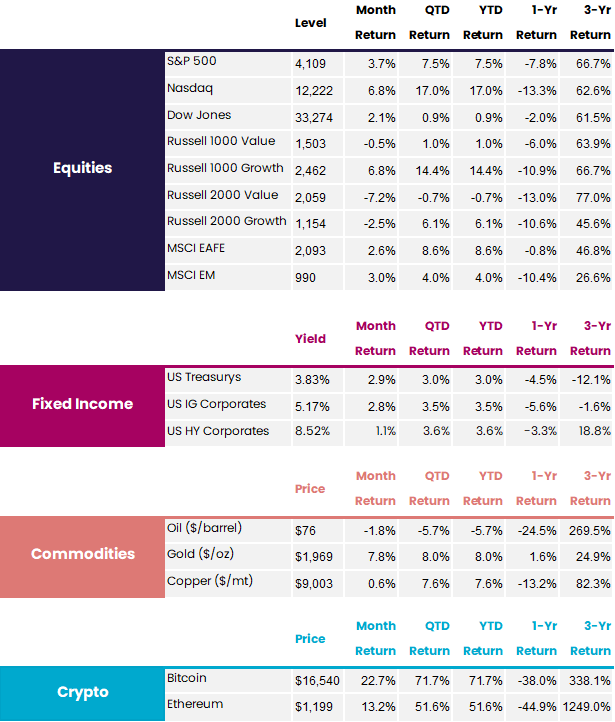March 2023 Market Lookback
Strong economic data to start the month was disrupted by contagion fears throwing financial stability and the hiking cycle into question. Market pricing went from four hikes in 2023 to four cuts in the span of a week, as the Federal Reserve’s resolve to fight inflation was challenged by a possible banking crisis. Treasury volatility intensified to the highest levels since the 2008 financial crisis, though equity market volatility remained comparatively subdued despite its own move higher. With financial stability concerns easing later in the month, some of the drawdown was retraced but economists’ recession odds remain higher than they were at the start of the month.
Macro
• The Treasury, FDIC, and Federal Reserve acted to head off a potential crisis stemming from deposit outflows at a handful of regional banks.
• The Fed raised the fed funds rate by 25bps to an upper bound of 5.00% on Mar 22.
• 311k jobs were added in February, the 11th straight upside surprise.
• Average hourly earnings grew 0.2% in February, below the consensus estimate of 0.3%.
• Feb CPI came in marginally above consensus on both a headline & core basis, at 6.0% & 5.5% y/y, and 0.4% & 0.5% m/m, respectively. Meanwhile, PCE inflation came in a touch below consensus on both a headline (5.0% y/y & 0.3% m/m) & core (4.6% y/y & 0.3% m/m) basis.
Equities
• Bottom-up EPS estimates for the S&P 500 in 2023 barely budged from $221 to $220 in March.
• Size was the best performing factor in March – the top size quintile of stocks beating the bottom quintile by 13.0%.
• FANG+ stocks outperformed the equal-weighted S&P 500 (i.e. the “average” stock) by 14.1%, the most since Aug 2020.
• Small- & large-cap growth stocks beat their value counterparts by 4.7% & 7.3%, respectively.
• After spending the first week of March below 20, the VIX surpassed 30 on Mar 13 in response to banking sector volatility before easing to finish out the month at 18.7.
Fixed Income
• After 2Y Treasury yields peaked at 5.08% on Mar 8, Treasury volatility intensified on financial stability concerns — the 2Y yield fell as low as 3.55% on Mar 24 before finishing the month at 4.03%.
• Treasury volatility, as measured by the MOVE index, rose to 198.7 on Mar 15, the highest level since the financial crisis of 2008.
• HY bond spreads rose from 4.54% on Mar 6 to 5.55% on Mar 15 — the widest since Oct 2022 — before eventually narrowing to 5.19% by the end of the month.
Crypto
• Buoyed by the significant decline in yields, Bitcoin & Ethereum prices posted their 3rd consecutive month of gains, the first such streak since early 2021.
It’s the Resteepening That Gets You
After beginning March 90bps inverted, the 2y10y Treasury yield spread inverted further to 110bps on Mar 8 as hot economic data and comments from Fed officials led to increased bets of rate hikes. However, once banking sector instability burst onto the scene, that move was more than unwound – from Mar 8 to Mar 13, the 2y10y spread moved from 110bps inverted to only 41bps inverted, as a result of the 2Y yield falling 114bps and the 10Y yield falling 45bps.
Many correctly point out that yield curve inversions tend to come before recessions, since lower long-term rates relative to short-term rates is a sign that the market expects rate cuts in the future. But when the yield curve steepens with short-term rates declining more than long-term rates, that’s seen as a sign that the market thinks those rate cuts are coming closer, indicating that the Fed will need to ease in response to negative news or worsening data.
Shortly before each of the last six recessions, the yield curve quickly resteepened as the expectation for imminent rate cuts was priced into the short-end of the yield curve. While history doesn’t necessarily repeat, it often rhymes. After being deeply inverted for such a long time, this resteepening could be the signal that economic data is nearing its breaking point. We’re watching this very closely.
Be Careful What You Wish For
While the Fed entered its quiet period just as financial stability concerns intensified, it’s not as if they didn’t see what was transpiring. There was (and still is) significant uncertainty about the economic ramifications of March’s volatility, so it wasn’t a surprise that the focus of the FOMC meeting on Mar 22 shifted from one of economic strength to one of potential weakness.
Gone were references to ongoing rate hikes and uncertainty surrounding the Russia-Ukraine conflict, with more emphasis on the possibility for additional policy firming. There was also an acknowledgement that tighter credit conditions, resulting from the recent bank turmoil, were likely to weigh on businesses and households. On top of that, while Powell indicated during his Mar 7 & 8 remarks to Congress that the terminal fed funds rate would be higher than anticipated, the median 2023 projection remained unchanged on the heels of the financial turmoil.
An NLP model from Bloomberg ranked the Fed statement as the most dovish since Jan 2021, despite no dovish pivot in rates. If the economy does weaken from here, there might be more dovishness in store from the Fed but be careful what you wish for. Dovishness due to weaker economic and corporate outlooks presents a different set of warning signs. Last year was a rate-related drawdown, but a recession-related drawdown is a challenge markets have not yet had to seriously face.
Performance data quoted represents past performance. Past performance does not guarantee future results. Market returns will fluctuate, and current performance may be lower or higher than the standardized performance data quoted.



